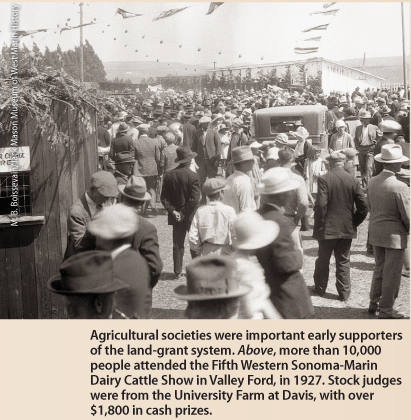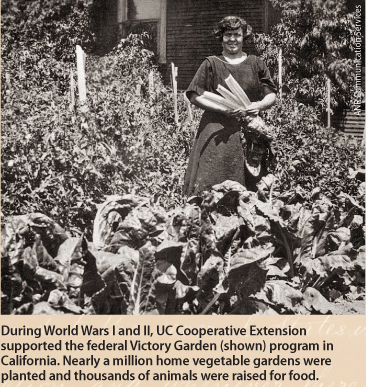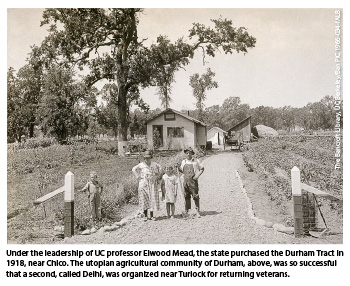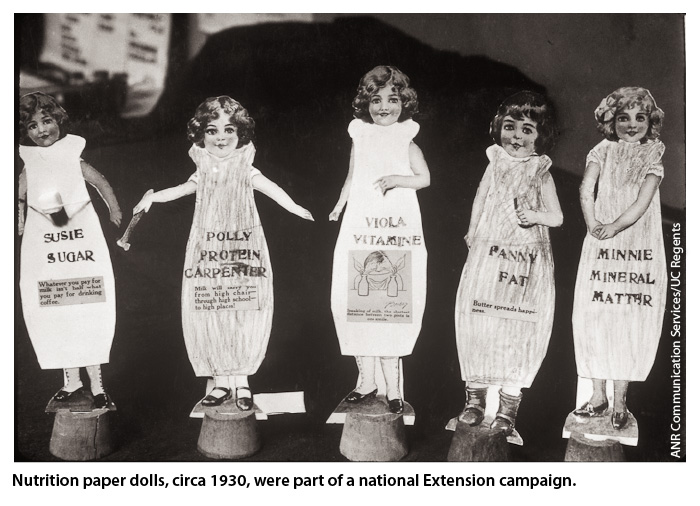All Issues
UC's land-grant mission fuels nation's growth, prosperity
Publication Information
California Agriculture 66(2):42-45.
Published online April 01, 2012
PDF | Citation | Permissions
Full text
This year marks the sesquicentennial, or 150th anniversary, of four events key to American agriculture. In 1862, the United States Department of Agriculture (USDA) was created. Three pieces of legislation were also passed that would forever change the face of the nation: the Pacific Railroad Act, the Homestead Act and the Morrill Land-Grant College Act, which created America's land-grant institutions, including the University of California.
In 1862, America was in its second year of the Civil War, which threatened the nation's very survival. It was an unsettled time. Battles such as Shiloh — which would haunt American memory for decades — and Lincoln's preliminary Emancipation Proclamation left Americans feeling uncertain, but also in the case of the North, bravely charting a new direction that expressed optimism despite the war. At that time, farmers made up more than 50% of America's labor force; legislation such as the Morrill Act reflected their importance, and reinforced the economic and social importance of agriculture to the nation's future. The Morrill Act also demonstrated the increasing importance of taking a more scientific approach to agricultural production and education.
Agricultural societies were important early supporters of the land-grant system. Above, more than 10,000 people attended the Fifth Western Sonoma-Marin Dairy Cattle Show in Valley Ford, in 1927. Stock judges were from the University Farm at Davis, with over $1,800 in cash prizes.
The creation of the USDA (President Lincoln called it “the People's Department”) institutionalized agriculture in the federal government; the agency was called “to diffuse among the people of the United States useful information on subjects connected with agriculture.” While creation of the USDA was vital to American agriculture, it was the Morrill Act that was truly visionary. It enabled state governments to provide higher education in agriculture, science and mechanical arts. With its passage, all states were given blocks of land by the federal government that could be sold off by legislatures to fund public universities.
Agricultural societies
Farmers have always sought and shared agricultural knowledge. Agricultural organizations, often called societies, were designed to share agricultural knowledge, and they were prevalent in early America. Leaders in Philadelphia formed a society to promote agriculture in 1785; others quickly followed suit. Many of the letters written by General George Washington during the Revolutionary War focused on agricultural practices and production at his plantation. Like fellow founding father Thomas Jefferson, Washington was an agricultural innovator.
Agricultural experimentation was particularly strong among wealthy Southern growers in the period prior to the Civil War, due in part to a decline in soil fertility combined with decreasing cotton prices in the 1840s and 1850s. By the 1860s, there were more than 1,300 agricultural and horticultural societies in the United States; some states were also creating state boards and departments of agriculture. Agricultural fairs (and later, expositions) were popular, and served not only as places to market goods but also as sites for education and demonstration; George Washington encouraged the movement as early as 1796. The United States Agricultural Society was formed in 1851 and enjoyed significant success until the Civil War, when sectional differences made its operation impossible.
Farmers were hungry for knowledge. Publications such as the American Farmer (which came to press in 1819) filled some of the gaps. By the end of the 19th century, more than 3,000 agricultural publications had appeared at various times in the United States and Canada; most quickly failed. But through these efforts an increasing amount of information about agriculture was produced and shared, and more farmers were accessing agricultural information. This created a political culture that supported the idea of land-grant legislation.
Land-grant legislation
Justin Smith Morrill introduced the land-grant bill in the U.S. House of Representatives in December 1857; it was accepted by a narrow margin in April 1858. The Senate passed its own version, which was vetoed by President Buchanan, who acceded to Southern interests opposed to the perceived growth of federal power that the Act represented. Later, however, President Lincoln proved favorable to the idea of industrial education (in fact, agricultural education was a repeating campaign theme when he stumped for president). With the Southern congressional members who had opposed the Morrill Act now seceded from the Union, the legislation was reintroduced and signed into law on July 2, 1862.
In September 1862, Iowa became the first state to accept the gift offered by the Morrill Act. By 1870, 37 states had signed on. A second Morrill Act in 1890 gave an additional boost to the land-grant system by fostering institutions serving African Americans in the Southern states.
In California, the Morrill Act enabled the state to combine federal, state and private funds and efforts (the private College of California was part of the genesis of UC). This led to the creation of the University of California in 1868. Shortly after, a new campus was built on a tract of land near Oakland, called Berkeley. From humble beginnings, UC grew to become one of the world's pre-eminent educational institutions, providing the knowledge and technical education that helped California become one of the world's primary agricultural producers.
The Morrill Act was visionary, but it did not prove an immediate success. It took years for the states to take full advantage of the legislation, and even then, the connection between the production of knowledge at the land-grant institutions and its practical application by farmers was lacking. Some of the problems experienced, including low enrollments and a failure to teach practical agriculture, led to further legislation in the form of the Hatch Act in 1887, which funded linked experiment stations to provide a practical place to help solve the problems of ordinary farmers. The 1905 State Farm Bill would fund establishment of the University Farm at Davisville in 1906, a teaching farm for UC Berkeley students. The Citrus Experiment Station in Riverside was founded in 1907; it proved vital to Southern California's developing citrus industry. In 1919, the California Legislature designated an existing teacher's college in Los Angeles as UC's southern branch; it became the UCLA campus in 1927 and offered some agricultural programs for decades. As a result of increased enrollment at UC due to the GI bill passed during World War II, the University Farm eventually evolved into the UC Davis campus. Likewise, the Citrus Experiment Station eventually gave rise to the UC Riverside campus. The original campus at UC Berkeley remained the flagship agricultural campus.
Responding to wartime needs
The period around World War I is one of the most interesting in the development of institutions such as UC, in part because of the passage of the Smith-Lever Act in 1914, which provided for “Cooperative Agricultural Extension Work,” a federal, state and county funding partnership that gave rise to the Cooperative Extension Service. The importance of scientific agriculture and the role of land-grant institutions in promoting agricultural productivity were highlighted during World War I, when agricultural production and food security were viewed as vital to national security and victory “over there.” When the United States entered World War I, national leaders feared an agricultural crisis. Many farmers and laborers were mobilized to war. Foreign labor, used in California, was deemed risky. International allies relied on shipments of U.S. food to avoid mass deprivation and starvation, as most of Europe became a battlefront and agricultural production there plummeted.
During World Wars I and II, UC Cooperative Extension supported the federal Victory Garden (shown) program in California. Nearly a million home vegetable gardens were planted and thousands of animals were raised for food.
Victory gardens.
Across the United States and in California, land-grant institutions helped the nation respond to wartime needs. In the quickly urbanizing nation, home food production again became a national priority, even an imperative. UC was involved in providing research, educational resources and training for the army of Victory Gardeners who arose from the civilian population to help raise food on the U.S. home front, encouraging local production and consumption in a national mobilization. It was thought that increased home food production and food conservation efforts would feed civilians, enabling America to increase its agricultural exports to foreign allies; this proved to be true.
Cooperative Extension supports youth via 4-H, as well as nutrition and community development programs. Early in the 20th century, 4-H was an innovative way to introduce new agricultural technologies to farming communities. Above, the Tomales Joint Union High School Club, with leader Charles Hampton (left), raised and sold pigs in Marin County in 1924.
School gardens.
UC's groundbreaking efforts in school garden work and agricultural education, much done in the decade prior to World War I — including a program called the California Junior Gardeners offered in conjunction with the Berkeley School District — enabled a national program called the U.S. School Garden Army (USSGA) to gain traction and engage tens of thousands of urban and suburban youth in school, home and community gardening efforts across the state. At Ann Street Elementary School in Ventura, where teachers had previously received school gardening instruction from UC, students raised 2 tons of potatoes.
Nearly a century later, UC remains a national leader in school, home and community gardening work. UC advances research about the importance of agricultural and nutrition education and helps homeowners, schools and communities launch gardening efforts. Nearly 5,000 UC Master Gardener volunteers in 44 California counties provided 258,000 hours of service to California communities in 2010. Urban agriculture thrived in the form of national Victory Gardens during World War I and World War II. Today UC supports urban gardening through programs such as the UC Cooperative Extension Los Angeles Common Ground Program and its Grow LA Victory Garden Initiative. Farm advisors and campus-based specialists work with small producers to find new markets closer to home, through Community Supported Agriculture (CSA) and Farm-to-School programs.
Food conservation.
During World War I, UC Extension agents also served as local food administrators, helping California communities conserve food by suggesting alternative foods on wheatless and meatless days, and in rationing scarce products such as sugar. During this period, UC hired new Cooperative Extension agents to work with youth and to help women learn best practices in food preservation. UC-trained Master Food Preservers do the same today. In counties 100 years ago, farm advisors worked with agricultural producers, in partnership with local farm bureaus and county government, to boost California's agricultural productivity. They do the same today, helping producers conduct field trials of new varieties, develop markets for new products, reduce pesticide use, improve water use efficiency, reduce impacts on water quality, and remain viable and competitive despite ever-changing conditions.
Women's Land Army.
UC played an instrumental role in one of World War I's more controversial efforts, the Women's Land Army (WLA), which sought to address labor shortages by deploying young women, mostly urban and suburban and many college-educated, to work as agricultural laborers on the nation's farms. UC employed young women first to help conduct an assessment of agricultural labor in the state, and then trained them for agricultural work at the University Farm at Davisville. These young women proved critical to California growers during World War I, and some women used their work in the WLA to press for national suffrage.
Under the leadership of UC professor Elwood Mead, the state purchased the Durham Tract in 1918, near Chico. The utopian agricultural community of Durham, above, was so successful that a second, called Delhi, was organized near Turlock for returning veterans.
UC nutrition programs have long encouraged healthy lifestyles while promoting California agriculture. Above, a Picnic Day float on the University Farm at Davis, circa 1939, featured the nutrient “fairies” in milk.
Land settlements.
During this period, UC professor Elwood Mead worked closely with the State of California to organize a novel land settlement project at Durham, in Butte County, to create a utopian agricultural community. Its first year proved successful, and a second settlement, specifically for returning war veterans, was organized at Delhi, a few miles from Turlock. Today, UC farm advisors once again work with returning veterans as part the USDA's Beginning Farmers and Ranchers effort. As the nation faces a potential crisis inherent in the aging of the American farmer, UC farm advisors train beginning and new farmers, many of them veterans, women and immigrants, to become producers, assuring California's agricultural future and enhancing the security of the world's food supply.
Post-World War II growth
In June 1944, President Roosevelt signed the Servicemen's Readjustment Act, also known as the GI Bill of Rights. This legislation matched the Morrill Act in its vision and national impact. Returning veterans boosted enrollment at UC, creating conditions for the state's phenomenal economic and social growth. Land-grant institutions such as UC proved to be the economic engine of the nation in the 20th century, creating a robust middle class, providing upward mobility for millions of Americans, and assuring America's pre-eminence in agriculture and science. They also provided a place where the nation's promise of equality could be achieved, in part, through accessible public education.
It is impossible to overstate the importance of the GI bill nationally and to the California economy. Nearly 8 million returning veterans participated nationally in the program in the first decade. During this period, UC trained farmers, engineers, teachers, doctors, scientists and others who helped boost California's economy and college enrollment. (U.S. college enrollment grew to nearly 30% by the late 1960s, up from less than 10% in the pre-war years).
In California, UC's research and agricultural education programs provided the basis for durable economic growth that has made our state one of the world's largest economies. The story of UC is writ large on California's cultural, economic and physical landscape, but it is also a personal story to many of us.
My connection to UC dates back to the mid-1960s, when my father — who received two degrees in the “mechanic arts” at a land-grant institution under the GI Bill — moved our family to California, in large part because of the vision of higher education presented by the state. Like earlier pioneers, we made our way West, not in a covered wagon but in a Ford station wagon. Like pioneers of the past, we were drawn by dreams of prosperity and the brighter future that the Golden State promised.
I grew up knowing from my father that I would attend UC, where I would receive the world's best public education. He was right on both counts. Each day, I reap the benefit of that education. I also reap the benefits of UC research and extension work in myriad ways, whether through the selection of California-grown fruit at the local grocery store (the variety patented by a UC scientist), or when taking my daughter to the local family practice clinic that is part of the UCLA Medical School's teaching program in my community.
During both World Wars, UC played an important role in the Women's Land Army, which addressed the nation's agricultural labor shortage.
UC has evolved from a single campus to 10 campuses spanning the state, which make significant economic contributions statewide. According to an independent 2011 economic impact analysis, UC generates $46.3 billion in economic activity annually and contributes $32.8 billion toward California's gross state product. For every $1 of taxpayer investment, UC leverages and produces nearly $14 in economic output, while supporting one in every 46 jobs in the state.
UC research has fueled national and international prosperity, but it also remains a local institution in a very real sense. Through UC's Cooperative Extension program, it supports agricultural producers, youth through 4-H and nutrition programs, natural resource managers and landowners and communities.
UC Master Gardener volunteers enable urban and suburban populations to engage in home food production and community beautification through gardening. UC advisors and volunteers instruct youth, teachers and parents in nutrition and the health benefits of consuming fruits and vegetables. Some lemons grown with advice from a UC farm advisor in an orchard several miles from my home are shipped around the globe; others stay locally, and are used by a small business to produce a coveted limoncello liqueur that is featured in local restaurants. UC connections are global and local, and every place in between.
In 1943, UC began administering the federal Emergency Farm Labor Project in California, which deployed youth, immigrants and other volunteers to areas where harvest assistance was needed. UC and USDA also provided training, transportation and housing assistance.
Service to land and citizens
With agricultural research investment declining, agricultural productivity threatened by a number of factors (including limited water and climate change), and the world's population expected to increase at a dramatic pace, what California can produce is desperately needed.
We tend to take for granted a safe, plentiful and inexpensive food supply, which helps to assure our nation's social and political security. But continued investment is required to sustain the vision of the Morrill Act, to help all Americans reap the promise of abundance our physical geography offers. How will we chose to support the land-grant mission in the next 150 years?
The mission of UC and the land-grant institutions, both at home and abroad, remains larger than our collective imagination. We were a nation of farmers at origin: we are still a nation of farmers at heart. The frontier as once envisioned may be gone, but the real frontier — the pursuit of knowledge — awaits our further exploration.












